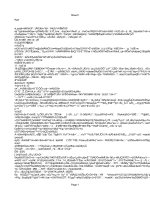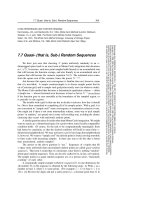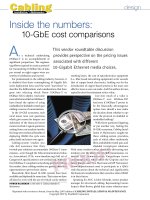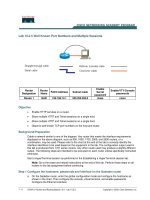Complex Numbers
Bạn đang xem bản rút gọn của tài liệu. Xem và tải ngay bản đầy đủ của tài liệu tại đây (341.08 KB, 16 trang )
551
CHAPTER
30
h '
>
2
2
% vt
Complex Numbers
Complex numbers are an extension of the ordinary numbers used in everyday math. They have
the unique property of representing and manipulating two variables as a single quantity. This fits
very naturally with Fourier analysis, where the frequency domain is composed of two signals, the
real and the imaginary parts. Complex numbers shorten the equations used in DSP, and enable
techniques that are difficult or impossible with real numbers alone. For instance, the Fast Fourier
Transform is based on complex numbers. Unfortunately, complex techniques are very
mathematical, and it requires a great deal of study and practice to use them effectively. Many
scientists and engineers regard complex techniques as the dividing line between DSP as a tool,
and DSP as a career. In this chapter, we look at the mathematics of complex numbers, and
elementary ways of using them in science and engineering. The following three chapters discuss
important techniques based on complex numbers: the complex Fourier transform, the Laplace
transform, and the z-transform. These complex transforms are the heart of theoretical DSP. Get
ready, here comes the math!
The Complex Number System
To illustrate complex numbers, consider a child throwing a ball into the air.
For example, assume that the ball is thrown straight up, with an initial
velocity of 9.8 meters per second. One second after it leaves the child's
hand, the ball has reached a height of 4.9 meters, and the acceleration of
gravity (9.8 meters per second
2
) has reduced its velocity to zero. The ball
then accelerates toward the ground, being caught by the child two seconds
after it was thrown. From basic physics equations, the height of the ball at
any instant of time is given by:
The Scientist and Engineer's Guide to Digital Signal Processing552
t ' 1± 1&h/4.9
where h is the height above the ground (in meters), g is the acceleration of
gravity (9.8 meters per second
2
), v is the initial velocity (9.8 meters per
second), and t is the time (in seconds).
Now, suppose we want to know when the ball passes a certain height.
Plugging in the known values and solving for t:
For instance, the ball is at a height of 3 meters twice: (going up)t ' 0.38
and seconds (going down). t ' 1.62
As long as we ask reasonable questions, these equations give reasonable
answers. But what happens when we ask unreasonable questions? For
example: At what time does the ball reach a height of 10 meters? This
question has no answer in reality because the ball never reaches this height.
Nevertheless, plugging the value of into the above equation gives twoh ' 10
answers: and . Both these answers containt ' 1 % &1.041 t ' 1 & &1.041
the square-root of a negative number, something that does not exist in the world
as we know it. This unusual property of polynomial equations was first used
by the Italian mathematician Girolamo Cardano (1501-1576). Two centuries
later, the great German mathematician Carl Friedrich Gauss (1777-1855)
coined the term complex numbers, and paved the way for the modern
understanding of the field.
Every complex number is the sum of two components: a real part and an
imaginary part. The real part is a real number, one of the ordinary
numbers we all learned in childhood. The imaginary part is an imaginary
number, that is, the square-root of a negative number. To keep things
standardized, the imaginary part is usually reduced to an ordinary number
multiplied by the square-root of negative one. As an example, the complex
number: , is first reduced to: , and then tot ' 1 % &1.041 t ' 1 % 1.041 &1
the final form: . The real part of this complex number is 1,t ' 1 %1.02 &1
while the imaginary part is . This notation allows the abstract term,1.02 &1
, to be given a special symbol. Mathematicians have long used i to denote
&1
. In comparison, electrical engineers use the symbol, j, because i is used&1
to represent electrical current. Both symbols are common in DSP. In this book
the electrical engineering convention, j, will be used.
For example, all the following are valid complex numbers: , ,1 %2j 1 &2j
, , , etc. All ordinary numbers, such as:&1 %2j 3.14159 %2.7183j (4/3) %(19/2)j
2, 6.34, and -1.414, can be viewed as a complex number with zero for the
imaginary part, i.e., , , and .2 %0j 6.34 %0j &1.414 %0j
Just as real numbers are described as having positions along a number line,
complex numbers are represented by locations in a two-dimensional display
called the complex plane. As shown in Fig. 30-1, the horizontal axis of the
Chapter 30- Complex Numbers 553
Real axis
-8 -7 -6 -5 -4 -3 -2 -1 0 1 2 3 4 5 6 7 8
-8
-7
-6
-5
-4
-3
-2
-1
0
1
2
3
4
5
6
7
8
2 + 6 j
-4 - 1.5 j
3 - 7 j
8j
7j
6j
5j
4j
3j
2j
1j
0j
-1j
-2j
-3j
-4j
-5j
-6j
-7j
-8j
FIGURE 30-1
The complex plane. Every complex number
has a unique location in the complex plane,
as illustrated by the three examples shown
here. The horizontal axis represents the real
part, while the vertical axis represents the
imaginary part.
Imaginary axis
A ' 2 % 6j
B ' &4 & 1.5j
C ' 3 & 7j
Re A = 2 Im A = 6
Re B = -4 Im B = -1.5
Re C = 3 Im C = -7
complex plane is the real part of the complex number, while the vertical axis
is the imaginary part. Since real numbers are those complex numbers that have
an imaginary part equal to zero, the real number line is the same as the x-axis
of the complex plane.
In mathematical equations, a complex number is represented by a single
variable, even though it is composed of two parts. For example, the three
complex variables in Fig. 30-1 could be written:
where A, B, & C are complex variables. This illustrates a strong advantage
and a strong disadvantage of using complex numbers. The advantage is the
inherent shorthand of representing two things by a single symbol. The dis-
advantage is having to remember which variables are complex and which
variables are ordinary numbers.
The mathematical notation for separating a complex number into its real and
imaginary parts uses the operators: and . For example, using theRe( ) Im( )
above complex numbers:
The Scientist and Engineer's Guide to Digital Signal Processing554
(a %bj) % (c %dj) ' (a %c) % j(b %d)
(a %bj) & (c %dj) ' (a &c) % j(b &d)
(a %bj) (c %dj) ' (ac &bd) % j(bc %ad)
(a %bj)
(c %dj)
'
ac % bd
c
2
% d
2
% j
bc &ad
c
2
% d
2
EQUATION 30-1
Addition of complex numbers.
EQUATION 30-2
Subtraction of complex numbers.
EQUATION 30-3
Multiplication of complex numbers.
EQUATION 30-4
Division of complex numbers.
AB ' BA
EQUATION 30-5
Commutative property.
EQUATION 30-6
Associative property.
EQUATION 30-7
Distributive property.
(A %B) %C ' A %(B %C)
A(B %C) ' AB %AC
Notice that the value returned by the mathematical operator, , does notIm ( )
include the j. For example, is equal to 4, not .Im(3 %4j) 4j
Complex numbers follow the same algebra as ordinary numbers, treating the
quantity, j, as a constant. For instance, addition, subtraction, multiplication and
division are given by:
Two tricks are used when manipulating equations such as these. First,
whenever a term is encountered, it is replaced by -1. This follows from thej
2
definition of j, that is: . The second trick is a way toj
2
' ( &1 )
2
' &1
eliminate the j term from the denominator of a fraction. For instance, the left
side of Eq. 30-4 has a denominator of . This is handled by multiplyingc % dj
the numerator and denominator by the term , cancelling all thec & jd
imaginary terms from the denominator. In the jargon of the field, switching
the sign of the imaginary part of a complex number is called taking the
complex conjugate. This is denoted by a star at the upper right corner of the
variable. For example, if , then . In other words, Eq. 30-Z ' a %bj Z
t
' a &bj
4 is derived by multiplying both the numerator and denominator by the complex
conjugate of the denominator.
The following properties hold even when the variables A, B, and C are
complex. These relations can be proven by breaking each variable into its real
and imaginary parts and working out the algebra.
Chapter 30- Complex Numbers 555
M ' (Re A)
2
% (Im A)
2
2 ' arctan
Im A
Re A
Re A ' M cos(2)
Im A ' M sin(2)
EQUATION 30-8
Rectangular-to-polar conversion. The
complex variable, A, can be changed from
rectangular form: Re A & Im A, to polar
form: M & 2.
EQUATION 30-9
Polar-to-rectangular conversion. This is
changing the complex number from M &
2 to Re A & Im A.
Real axis
-8 -7 -6 -5 -4 -3 -2 -1 0 1 2 3 4 5 6 7 8
-8
-7
-6
-5
-4
-3
-2
-1
0
1
2
3
4
5
6
7
8
2 + 6 j or
M = % 40
2 = arctan (6/2)
3 - 7 j or
M = % 58
2 = arctan (-7/3)
-4 - 1.5 j or
M = % 18.25
2 = arctan (-1.5/-4)
8j
7j
6j
5j
4j
3j
2j
1j
0j
-1j
-2j
-3j
-4j
-5j
-6j
-7j
-8j
FIGURE 30-2
Complex numbers in polar form. Three
example points in the complex plane are
shown in polar coordinates. Figure 30-1
shows these same points in rectangular
form.
Imaginary axis
Polar Notation
Complex numbers can also be expressed in polar notation, besides the
rectangular notation just described. For example, Fig. 30-2 shows three
complex numbers in polar form, the same ones previously presented in Fig.
30-1. The magnitude is the length of the vector starting at the origin and
ending at the complex point, while the phase angle is measured between
this vector and the positive x-axis. Complex numbers can be converted
between rectangular and polar notation by the following equations (paying
attention to the polar notation nuisances discussed in Chapter 8):
This brings up a giant leap in the mathematics. (Yes, this means you should
pay extra attention). A complex number written in rectangular notation
The Scientist and Engineer's Guide to Digital Signal Processing556
EQUATION 30-10
Rectangular and polar complex numbers.
The left side is the rectangular form of a
complex number, while the expression on
the right is the polar representation. The
conversion between: M & 2 and a & b, is
given by Eqs. 30-8 and 30-9.
a %jb ' M (cos 2 % j sin 2 )
EQUATION 30-11
Euler's relation. This is a key equation
for using complex numbers in science
and engineering.
e
jx
' cos x % jsin x
e
jx
'
j
4
n '0
( jx)
n
n!
'
j
4
k '0
(&1)
k
x
2k
(2k)!
% j
j
4
k '0
(&1)
k
x
2k%1
(2k %1)!
is in the form: . The information is carried in the variables: , buta %bj a & b
the proper complex number is the entire expression: . In polar form, thea %bj
key information is contained in M & 2, but what is the full expression for the
proper complex number?
The key to this is Eq. 30-9, the polar-to-rectangular conversion. If we start
with the proper complex number, , and apply Eq. 30-9, we obtain:a %bj
The expression on the left is the proper rectangular description of a complex
number, while the expression on the right is the proper polar description.
Before continuing with the next step, let's review how we arrived at this point.
First, we gave the rectangular form of a complex number a graphical
representation, that is, a location in a two-dimensional plane. Second, we
defined the terms M & 2 to be consistent with our previous experience about
the relationship between polar and rectangular coordinates (Eq. 30-8 and 30-9).
Third, we followed the mathematical consequences of these actions, arriving at
what the correct polar form of a complex number must be, i.e.,
. Even though this logic is straightforward, the result isM(cos2 %j sin 2)
difficult to see with "intuition." Unfortunately, it gets worse.
One of the most important equations in complex mathematics is Euler's
relation, named for the clever and very prolific Swiss mathematician,
Leonhard Euler (1707-1783; Euler is pronounced: "Oiler"):
If you like such things, this relation can be proven by expanding the
exponential term into a Taylor series:
The two bracketed terms on the right of this expression are the Taylor series
for and . Don't spend too much time on this proof; we aren't goingcos(x) sin(x)
to use it for anything.









